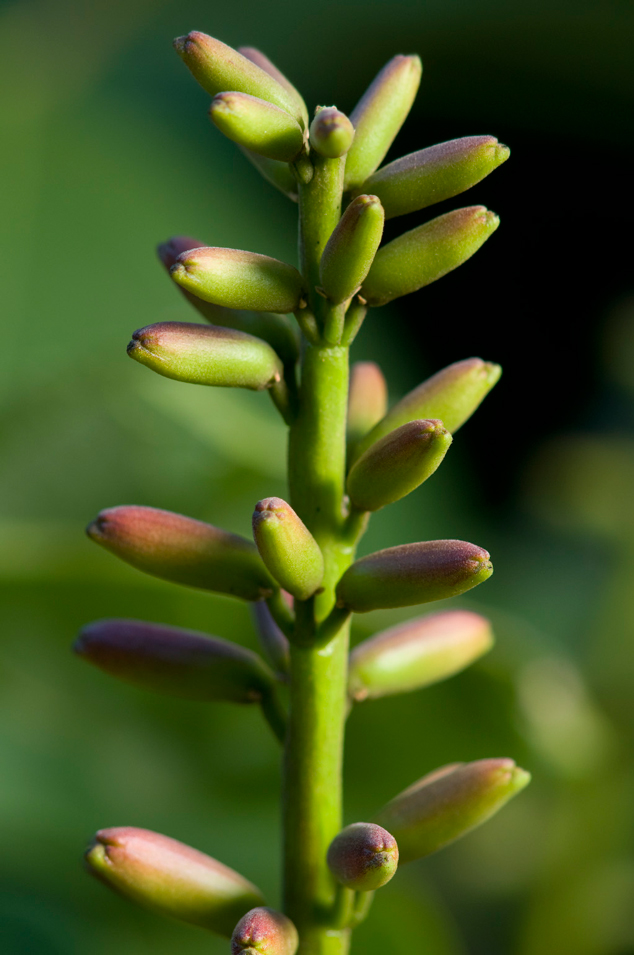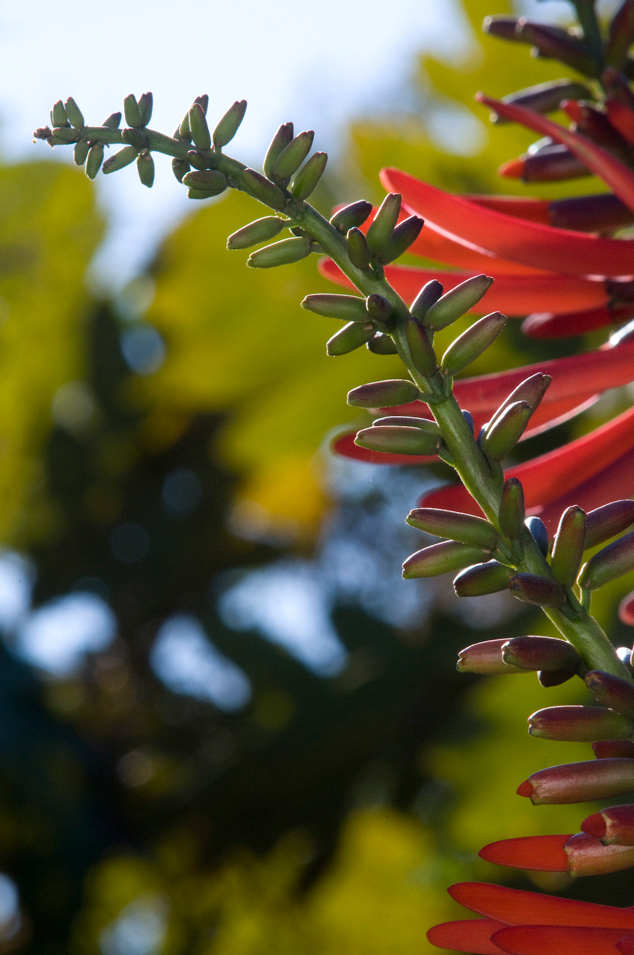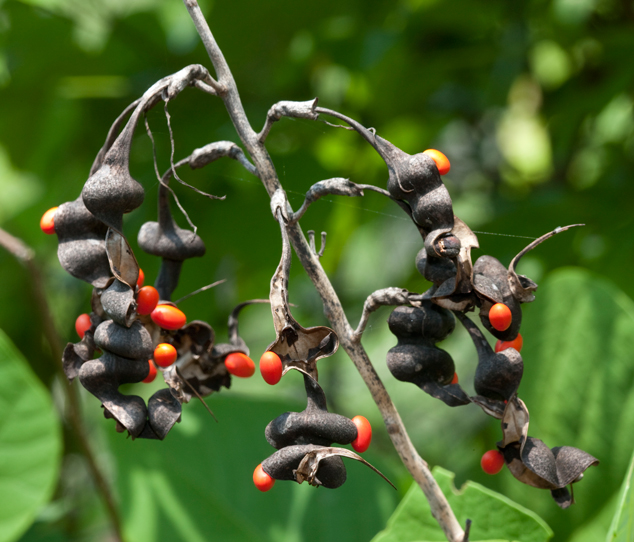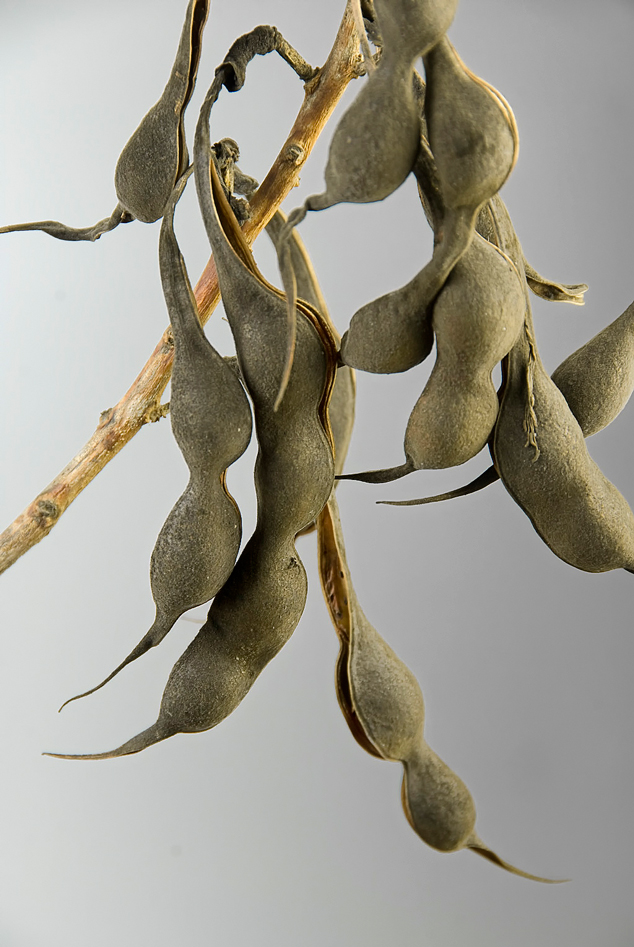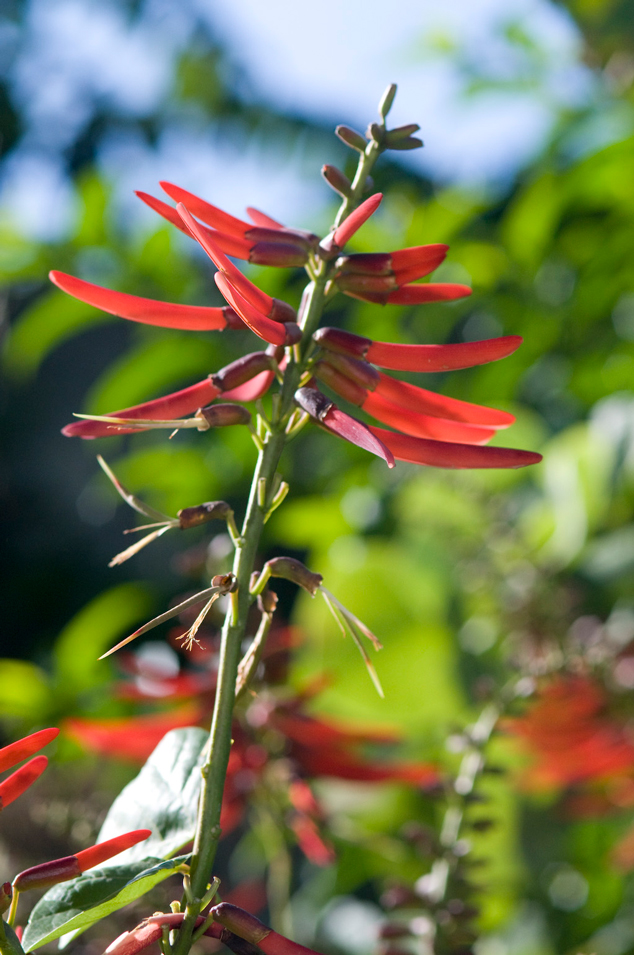Introduction
The bright red seeds of the Coral Tree of Quiche region of Highland Guatemala were used as divination tokens by the pre-Columbian Quiche Maya. The myth of the Popol Vuh mentions these colorful red seeds of the Tzite tree very clearly.
The tree is easy to grow as it readily sprouts from any branch that you cut off and stick in the ground. Reportedly seeds also sprout without special preparation of the seed. FLAAR has a healthy young Palo de Pito in our ethnobotany garden. It came from a branch that was given to us. It grew slowly but steadily and flowered after at least the first or second year. Our garden is at the elevation of Guatemala City, Central America (about 1500 meters), which is an appropriate elevation for this tree.
The flowers are red and elongated likeness to a whistle. The fruit is a pod of up to 20 cm long that can be twisted. The seeds are bright red.
Palo de pito, Erythrina berteroana buds, FLAAR Photo Archive
Palo de pito, Erythrina berteroana buds and flowers, FLAAR Photo Archive
Binomial botanical nomenclature for palo de pito
Anthropologist Dennis Tedlock calls the tree Erythrina corallodenron. I am rarely surprised to note that archaeologists and ethnographers do not use the same scientific names for plants or animals as do practicing botanists and zoologists.
The authors of Trees in the Life of the Maya World call it Erythrina berteroana Urban. Since their book was published by the Botanical Institute of Texas, I would assume that they had access to modern nomenclature (2006, since their book was published in 2007). This same botanical name is provided by the Guatemalan botanist and author Luis Villar. Again, botanists are using the “correct” name and ethnographers are using a different name: this issue occurs over and over again, and is confusing for archaeologists, iconographers, and epigraphers (who understandably do not have time to understand all this technical jargon).
The Highland Mayan Quiche name is Tzite. It is called Palo de Pito in Spanish because you can make a kind of whistle from the leaves.
Other botanists give the name as Erytrina (sic) macrophylla (Diccionario bilingüe estándar Kaqchikel ilustrado, Filiberto Patal Majzul Lolmay, p. 500). So by no means are all botanists using the same terms. Or, there may be several species, one in each different environmental zone.
Modern uses of the palo de pito
The seed is poisonous, and as a result the US Customs does not allow tourists to bring back the pretty necklaces made from the bright red seeds. But, the leaves and flowers are reported to be edible (Aguirre de Riojas and de Pöll 2007: 35).
Villar mentions that the wood of this tree was used for carving masks in Joyabaj (2006: 45).
Its red flowers and fleshy unopened young leaves and branches are used as food both by humans and domestic animals. Its used as food by the howler monkeys, squirrels and other mammals and birds that feed on flowers and small fruits. The seeds are used to make bracelets, necklaces and other handicrafts, which they say attract "good luck". The children use the flowers as whistles. It is believed that the flowers under the pillow will induce sleep. The bark produces a yellow dye used in textiles.
Palo de pito seed pods, Erythrina berteroana, notice the color of the seed that are toxic, used to make bracelets, necklaces and other handicrafts, FLAAR Photo Archive
Palo de pito Erythrina berteroana close seed pods. FLAAR Photo Archive
Palo de pito Palo de pito Erythrina berteroana flower, notice the red and elongated flower likeness to a whistle, FLAAR Photo Archive
Thesis potential: Indigenous names for Erythrina berteroana
The list of Mesoamerican terms for this tree is worth looking at because it includes the Nahuatl words for “Skull Rack,” Tzompantli.
I find several terms that should be followed up with more ethnohistorical, linguistic, epigraphic, and iconographic studies: namely “Tree of the Red Puma” and “Madre cacao” (a name for almost any tree that is used in cacao orchids to provide leafy shade).
It would be worthwhile tracking down the names for this tree in Lacandon, Chol, and Chorti languages, though the tree is potentially better known in the Highlands.
Thesis potential: Maya uses of the seeds, leaves, and flowers besides in divination
We provide a separate PowerPoint presentation, with lots more photos, and additional information on the Palo de Pito being used for purposes other than seeds for divination by shamens. In a PowerPoint we can include dozens of photographs that won’t really fit on a web page.
Thesis and dissertation potential: other plants besides Tzite used in divination
Divinition in Mayan rituals is a good topic for thesis or dissertation because so much is involved: incense, alcohol, religion, and potentially plants other than Palo de Pito.
Last update 16 August 2011.
First posted July 07, 2011.


